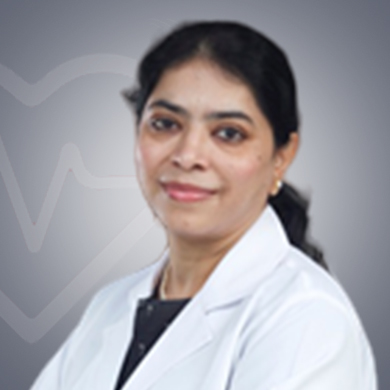
Gynaecologist
Verified
NMC Specialty Hospital , Abu Dhabi, United Arab Emirates25 Years of experience
Speaks: English
USD 180 USD 150 for video consultation
Consultations Completed
Recent Consultations
Dr. Surekha Pai is an expert and renowned obstetrician and gynecologist with around 25 years of experience in her field of interest. She is well known for delivering high-quality services to her patients. Dr. Surekha Pai uses a humanistic approach to providing evidence-based treatments for gynecological problems. She supports patients during pregnancy and childbirth and has experience in devising birth plans for high-risk pregnancies. With a track record of more than 10,000 successful gynecological treatments and deliveries, Dr. Surekha Pai is one of the most coveted gynecologists and obstetricians in Dubai. Her expertise lies in performing cosmetic and laparoscopic gynecological procedures and the management of high-risk pregnancies. At present, she is a specialist Obstetrician and Gynecologist at NMC Royal Hospital, DIP, Dubai.
After doing her MBBS at the Kasturba Medical College, Manipal(KMC) in India, she completed a specialized degree, MD in Obstetrics and Gynecology at the same institute. This course helped her develop knowledge and specialized skills for addressing problems associated with the female reproductive system. She gained expertise in managing gynecological issues like abnormal pregnancies and premature children. Additionally, she also qualified for examinations to become a member of the Royal College of Obstetricians and Gynecologists(UK) in 2006, and in 2018, she also became a Fellow of the Royal College of Obstetricians and Gynecologists(FRCOG). After achieving this feat, she also got inducted as a Fellow of Minimal Access Surgery in 2009. Upon the completion of her medical training, Dr. Surekha Pai began her medical career as an Obstetrician and Gynecologist at the Delma Hospital in Abu Dhabi. Prior to becoming an Obstetrics and Gynecology specialist at the NMC Royal Hospital, Dubai, she had extensive experience working at different hospitals in Oman and India.
As a well-qualified and proficient obstetrician and gynecologist, Dr. Surekha Pai has expertise in performing laparoscopic gynecological procedures and providing treatments in case of high-risk pregnancies. She also provides routine checkups for pregnant women. Her expertise spans treatments for gynecological conditions like menopause, PCOD, uterine fibroids, endometriosis, and performing tests like breast exams, and prenatal screening. She is also adept at using ultrasound for monitoring pregnancy. Dr. Surekha Pai is also trained in procedures like labor induction.
In her decades-long medical career as an obstetrician and gynecologist, Dr. Surekha Pai has helped many women with childbirth even in cases of high-risk pregnancies. Her praiseworthy efforts have not only helped patients but have also helped in advancing the field of obstetrics and gynecology.
Telemedicine sessions with an expert obstetrician and gynecologist like Dr. Surekha Pai can guide people who are looking for supportive care and medical care during their pregnancies as well as women who are struggling with various gynecological diseases. Reasons why you should consider a telemedicine session with her include:

You can book a video consultation with Dr. Surekha Kalsank Pai on our platform

Share Your Experience about Dr. Surekha Kalsank Pai

Dr. Surekha Pai is an efficient and competent obstetrician and gynecologist with more than 25 years of experience.
Dr. Surekha Kalsank Pai specializes in providing medical care for high-risk pregnancies and performing laparoscopic surgeries for treating numerous gynecological problems.
She offers treatments for conditions like menopause, uterine fibroids, high-risk pregnancies, PCOD, and other gynecological problems.
She is currently affiliated with the NMC Royal Hospital, DIP, Dubai as a specialist in obstetrics and gynecology.
Consultation with an ObGyn specialist like Dr. Surekha Pai costs 150 USD.
She is registered with the Dubai Health Authority.
To schedule a telemedicine session with Dr. Surekha Pai, consider the following steps:
Gynecologist Laparoscopic Surgeons are specialists who perform a wide variety of tests focused on women's health. They are responsible for performing exams on adult women to check their reproductive health. During the exam, the doctor physically examines the woman, performs STD test, does a breast exam, and monitors use of birth control. Gynecologists sometimes are certified as obstetricians, who look after the health of the mother and the child during pregnancy. The Gynecologist Laparoscopic Surgeon evaluates the condition of the patient before starting a treatment. There are many other works that a gynecologist handles like monitoring general health problems that generally a general physician addresses. They also perform diagnostic tests to find out the underlying conditions. Some other conditions that a gynecologist can treat are polycystic ovarian syndrome, cervical cancer.
Gynecologist Laparoscopic Surgeons perform the below-given tests to diagnose conditions related to female reproductive systems:
Different gynecological disorders may have different symptoms. It is important to discuss your symptoms with your doctor so that they can evaluate the symptoms and recommend a few tests to find out the underlying condition causing the symptoms. The doctor then designs your treatment based on the test report. The doctor may also talk to other doctors to discuss the treatment plan.
Regularly visiting a gyno is very essential for the health of female reproductive organs. Below listed are some symptoms that suggest that you must see a Gynecologist Laparoscopic Surgeon so that condition can be diagnosed: